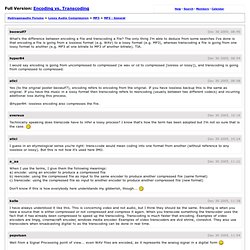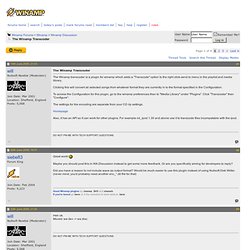

Transcoding. Transcoding is the direct analog-to-analog or digital-to-digital conversion of one encoding to another,[1] such as for movie data files (PAL, SECAM, and NTSC, Etc.) or audio files (MP3, WAV, Etc.). This is usually done in cases where a target device (or workflow) does not support the format or has limited storage capacity that mandates a reduced file size,[1] or to convert incompatible or obsolete data to a better-supported or modern format. In the analog video world, transcoding can be performed just while files are being searched, as well as for presentation. For example, Cineon and DPX files have been widely used as a common format for digital cinema, but the data size of a two-hour movie is about 8 terabytes (TB).[1] That large size can increase the cost and difficulty of handling movie files. In contrast to a conversion, the prefix "trans" emphasizes a conversion from a source to a different destination.
[citation needed] Process[edit] Re-encoding/recoding[edit] Editing Lower bitrate. Generation loss. Digital generation loss induced by rotating a JPEG image 90 degrees (from top to bottom) 0, 100, 200, 500, 900, and 2000 times (without using lossless tools) Generation loss refers to the loss of quality between subsequent copies or transcodes of data.

Anything that reduces the quality of the representation when copying, and would cause further reduction in quality on making a copy of the copy, can be considered a form of generation loss. File size increases are a common result of generation loss, as the introduction of artifacts may actually increase the entropy of the data through each generation. Analog generation loss[edit] Generation loss was a major consideration in complex analog audio and video editing, where multi-layered edits were often created by making intermediate mixes which were then "bounced down" back onto tape. Digital generation loss[edit] Used correctly, digital technology can eliminate generation loss. Techniques that cause generation loss in digital systems[edit] Hydrogenaudio Forums > Encoding vs. Transcoding. I realize this post is a couple years old, but I was asked a question today, and this specific post was mentioned in the course of the conversation.

This post still comes up on Google searches, even if it's "old" by forum standards (Google can be blind to age). QUOTE (a_aa @ Dec 30 2005, 05:20) Nor should you be! The terms are definitely not interchangeable. Technically, a re-encode can be a transcode, but not all transcodes are re-encodes. QUOTE (kalle @ Jan 1 2006, 10:02) Here is a link that mentions converting between different formats without full re-compression.
"Compressed Domain Transcoding" is a very narrowly defined type of transcode that is not synonymous with "re-encode".The link to that paper is now dead. QUOTE (kalle @ Jan 2 2006, 07:44) As I understand it, the video is not fully re-encoded........The benefit is speed, but I think the quality is actually worse than when you do a full re-encode. Correct on both counts. Showthread. Dear Will, Greetings and thanks so much for the brilliant Transcoder plugin.

I just purchased the Pro version on Winamp and I wanted to encode aacPLUS v2 files from the wav files in my hard drive. I tried the Transcoder but the plugin crashes while transcoding wav files to aacPLUS v2. This has also been reported in this thread Surprisingly it works perfectly when I tried to reverse transcode a aacPLUS v2 file to a mp3. So it looks like it must be a small bug. Can you please please solve this aacPLUS v2 encoding problem with the Transcoder plugin as without it I have no option but to take the real long way to encode from wav to aacPLUS. Your kind help in this matter will be very much appreciated with gratitude.
PS.